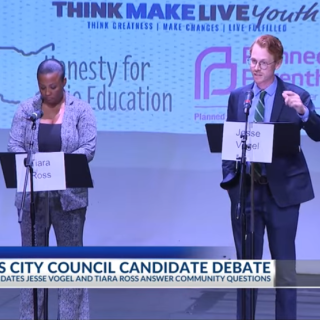In its continuing private interest- and large public institution-dominated efforts to avoid the popular democratic reforms that remade almost all US cities in the second half of the nineteenth century and even more in the early twentieth-century Progressive Era, Columbus, Ohio (which continues to need its state’s name to be recognized) created “area commissions” and “district organizations” in the early 1970s. It was one of many anti-public dodges to avoid representative democracy and maintain private interests, often bought and sold with mayors’, city councils’, and major departments’ participation. This is the well-known Columbus Way.
These are strange entities, full of contradictions, pursuits of self-interest, and both active and passive deceptions. The only serious commentary I have found is a few pages in geographer Kevin Cox’s Boomtown Columbus: Ohio’s Sunbelt City and How Developers Got Their Way (2021), the only scholarly documented study of Columbus in print.
Cox highlights the complications and contradictions:
"The demand for elections by ward in Columbus is long-standing. One of the ways in which the city has responded, short of providing what was being asked for, has been the creation of area commissions that would act as intermediaries between, on the one hand, residents, and, on the other, developers and city officials."
Not surprisingly, “This process started in the early 1970s,” a time of civic turmoil in Columbus like many other cities. Today, few recall that as both students and many other residents rallied in protest on the Ohio State University campus after the Kent State massacres in May-June 1970, the university called out the Columbus police who conducted a riot against the protesters. CPD’s May-June 2020 actions have powerful precedents.
This was also a time in which “traditional,” private homeowner neighborhoods within the city struggled legally and extra-legally to preserve themselves through restrictive covenants, red-lining, discrimination in mortgage loans, and personal actions. Columbus, Ohio was and remains highly segregated.
In fact, these were the grounds for the pioneering research that culminated in the legal studies field with the easily-distorted name of critical race theory. Race, ethnicity, social class, and gender were active factors in Columbus as throughout the US.
Cox continues,
"Establishment of a commission requires a petition from the residents in the area in question. There are now seventeen of them, though with a notable absence in the far north. They cover a variety of areas, though interestingly not the gentrifying ones, except as parts of broader areas. Rather German Village and Victorian Village have separate bodies, still named commissions, appointed by the mayor, and charged with historical and architectural preservation."
In no way no they resemble wards or serve popular interests democratically. Few of them resemble either neighborhoods or communities as those words are usually employed especially in legal or social research terms. They exist in contrasting forms of “advisory,” adding to both self- and other-confusion. At base, they are special interest groups, the opposite of how Cox sees their origins.
Multiple contradictions serve private interests. There is the University District Organization which is not aware that there is actually a separate, historic, residentially-zoned University District that is only one of the UDO’s thirteen “neighborhoods.”
That is, twelve of them are not in the University District. And when examined, few are functioning neighborhoods in either the ordinary or the academic meanings of that word. They are a collection of a few streets, like Dennison Place, Glen Echo, Indianola Forest or Terrance, Iuka Ravine, and so on. Yet, some of these tiny clusters have their own “area commissions.”
To take another example, the Circles small group of streets in Victorian Village apparently does not know that it is in the central part of Victorian Village. According to my informants, its residents believe that they live in the University District not Victorian Village. Here is Columbus’ inseparable endemic lack of identity and history.
The UDO’s executive director does not know this, or the history of the actual UD. I recently provided them with a copy of the only documented historical study of the area, a 2017 Journal of Social History article based on research that began as an OSU senior honors thesis by Dr. Ellen Manovich.
On its website, the UDO promotes one of two mythical, undocumented books by the UAC’s former non-historian leaders that falsely purport to be histories. This, we know well, is the Columbus Way. Columbus, Ohio, is defined by geographic as well as political and historical “illiteracy,” better construed as willful ignorance. The UDO and other area commissions all seek to promote and expand their “identity.” Unfortunately, none of them can identity their “identity.”.
I cannot discern if this confusion is rooted in ignorance or political deceit. But it is not accidental that OSU students—who resided in the UD for all of OSU’s history and have in recent decades, living as tenants in non-resident-owned typically large property-owning companies’ buildings, constitute a majority of University District residents, are conspicuously absent from the specific concerns of the University Area Commission and the University Neighborhood Organization, which are based in the actual UD, and the UDO which more or less surrounds the UD on three sides. A great many students also live in Victorian Village and other of the 13 “neighborhoods.”
It does not help matters that the City of Columbus has at least four different maps of the UD which differ from each other on its websites. None of them include the UDO’s thirteen neighborhoods.
Paraphrasing the City’s enabling legislation for the area commissions and organizations, Cox summarizes,
"Each area commission has a board with members elected by area residents. Boards consider planning and development issues affecting the area in meetings open to the public and make requests of, and recommendations to, the city, but their functions are strictly advisory."
Based on a few notorious cases outside the UD and UDO-areas, Cox incorrectly or at least incompletely believes that the commission have power; “this is not mere parish pump politics…. Even so, their effectiveness when coming up against the entrenched power of the developers in the city of Columbus has been seriously questioned.”
In fact, with respect to the University District and its adjacent areas, this is not completely true. The developers and these “area power brokers” may align powerfully more broadly and cooperatively than they conflict. The commissions are not democratic intermediaries or representative bodies.
First, my wife and I have lived for more than eighteen years in a now 107-year old house that we own in the University District. Never once have we been asked to vote or been told about a meeting of the UAC, UDO, University Area Review Board UARB), University Community Business Association (UCBA), or any other associations.
Several former leaders know us, our commitment to our neighborhood, my knowledge as an urban historian, and the original local research of my OSU students. Some of them heard an illustrated presentation of Manovich’s original research to the now defunct Indianola-Forest Homeowners but did not stop myth-mongering orally or in print.
I suspect that their knowledge accounts in fair measure for our exclusion. As I now work actively with both the City government and OSU—and have personally brought agents of both together, first in my living room—I have never heard a word or been contacted by University Area Commission, University District Organization, or the rest of the alphabet soup, all subservient to The OSU, large landlords, and business interests. Commission and organization representatives have been added to distribution lists of my frequent communications with both the City and OSU. They remain silent.
My observations for almost two decades persuade me that the area commissions and district organizations, regardless of their origins—about which my long-term neighbors who witnessed their origins conflict—do not function as democratic or representative. Their leadership is self-reproducing and out of touch with realities on the ground in their “areas,” “districts,” or “communities.”
They are selectively self-, rather than community-interested. Especially in the University District and the areas closest to OSU, they advance the interests of the neighbor-destroying outside developers, along with OSU’s own Campus Partners for Urban Community Development, the partner of major developers, not any identifiable community.
The UAC and UDO took no role in either preventing or moderating the destruction of the attractive, historic University District and also Weinland Park by literally illegal creation of large landlords whose presence violates the terms of the 1914 City Charter and zoning codes, long in need of thorough revision.
Contradictorily, other area commissions and most of the UDO neighborhoods strived to protect their residential neighborhoods.
Secondly, if formally “advisory,” the area commissions have a major role in approving proposals for new structures that exceed zoning code regulations. On the one hand, this contributed to the destruction of the landmark, beloved by generations of OSU graduates, east side of High Street across from Ohio State University, and its replacement with an unattractive brick wall separating campus from the city. OSU has never been an urban university.
On the hand, battles are fought and sometimes won in the area design review committee over grossly inappropriate structures repeatedly proposed for High at Lane and Lane Ave. across from OSU. The area commissions often have a loud voice.
I recently learned from the head of Columbus zoning that area commissions also have major authority in granting variances to large property owners to own more than the minimum number of buildings and also violate zoning regulations on size and number of signs in residentially-zoned area. The UAC’s historical inaction underlay the transformation of the attractive, historic, still officially zoned residential area. In its remaking and daily life, it bears no relations to a historic residential area.
Not surprisingly, not only the commissioners and executive directors, but also landlords and students do not know these facts. Nor do City Councilors, staff, and Columbus Police officers who presume that the UD is “campus” and that, illogically, the law does not apply especially on OSU football weekends. Just a few weeks ago, a CPD officer informed me to my face: “breaking the law is reasonable behavior on a game day.” Other officers and drunken students, along with a few drunken fathers, have told me and other homeowners that we “should move to Upper Arlington.” So much for the commissions’ pursuit and promotion of “identity.”
The largest landlords, well-known to students and homeowners alike, violate numerous city laws, cheat their tenants in many ways, do not repair their properties, charge excessive rents, and not cooperate with OSU or the City. The single-worst rated firm, with most complaints to OSU Student Legal Services, law suits, and online complains, makes it clear that it is certain that the law does not apply to them. So too do its major competitors, and many of their tenants. Is it surprisingly that the first firm has donated at least $5 million to OSU and appears on its website as OSU Student Housing (which it is not).
Three other large landlords—OSUapartments, OSUlive, OSUproperties--incorporate OSU into their names without OSU permission. OSU does not object. Students and their parents are not warned; they are misled. The commissions and organizations are silent. Money changes hands above and below tables.
Where is the UAC, UCA, or UDO? In fact, their leaders are on the quiet streets in the Circles in Victorian Village, Dennison Place, and isolated Iuka Ave. in the UD.
What do they do? They protect their own property values but especially in the UD itself, not those of their neighbors or the district at large.
The UDO embarks on a sloganeering promotion of “BeWell” that as far as I can tell has no rhyme or reason, any more that the ungrammatical awkwardness of its name. What does it mean, in fact, “to address concerns about housing, safety and feel connected as a community,” especially with hardly a word about students and the unsafe, unsanitary, and unmaintained housing of tens of thousands of students? What does “walkability” within a relatively small area mean? This is OSU and City of Columbus, Ohio-style sloganeering.
We get closer to the core when we see that BeWell is a collaboration with the overflowing slogan Neighborhood Design Center (NDC), itself the result of an OSU and City of Columbus partnership, with few credits of substance in its forty year history. About BeWell, the UDO executive director states, “This could look like advocating for policy, or helping long-term residents be able to stay in place.” I do not know what she means.
They get to the core, in City- and OSU-speak: “We know we have a lot of investments here to help [investors] feel comfortable.” Investors? The private developers bought the UD from the 1970s through the present with all but automatic city and commission variances from the legal codes. Any discomfort those “investors” feel comes at the hands of the few of us who continue to fight for the rights of the residentially-zoned historic neighborhood of students in close relationships with the homeowners.
Uninterested in that for more than 50 years, the UDO misrepresents the UD—confusing it with 13 distinct neighborhoods—as “one of the most diverse and exciting areas of Columbus.” It commissioned a poorly-formulated and conducted “survey” from the NDC that largely excluded the student population.
Over seven months, the survey achieved only “nearly 500” responses of which “over 57 percent were residents, with 65 percent of those being homeowners.” As for diversity, 81 per cent were white; only 25% were 25-34. An undefined and unexplained “65 stakeholders” were “engaged.” Who are the “investors”? The “findings” are unremarkable and lacking in substance.
But the “65 stakeholders” suggests the underlying foundations and motivations. Never a self-motivated for a democratic intermediary in the UD proper or 12 other “neighborhoods,” the UDO along with the UAC and UCA serves the City, OSU, local businesses, and property owners small and large. Its partner in its 2013 Strategic Plan is the University Community Business Association.
Its most recent 2017 organizational goals are undefined, empty rhetoric, from “positive growth” and “visionary and planning… catalyst.” Among its objectives are to “continue to improve” its own and its partner business association’s “organization capacity” and to “increase knowledge of and participation in UCBA for businesses not represented within a special improvement district.”
Can anyone tell me what that means? UDO like UCA and UAC are agents for the City itself, OSU, and private interests including some homeowners in some areas, not the aspirational goals for an intermediary between the City’s history of at-large, unrepresentative, undemocratic government at the beck and call of private corporations, and the great majority of residents. What Kevin Cox sought to discover in the community associations’ origins in the 1970s did not and does not define their past or present.
I cannot say if these commissions, associations, and organizations had a firm purpose and a genuine neighborhood basis at their time of founding or later. Regardless, it is clear that that simply does not exist recently or today.
I conclude by calling for the abolition of self-reproducing undemocratic City and OSU-linked false “community” organizations, and the active pursuit of representative democratic government for the first time in Columbus’ 220 year history. They are anachronistic misrepresentations of the area’s and areas’ publics. Their raison d’etre is the propagation of self-serving myths of a history than never existed.
----------------------------
Harvey J. Graff is Professor Emeritus of English and History at The Ohio State University and inaugural Ohio Eminent Scholar in Literacy Studies. Author of many books, he writes about a variety of contemporary and historical topics for Times Higher Education, Inside Higher Education, Academe Blog, Washington Monthly, Publishers Weekly, Against the Current; Columbus Free Press, and newspapers. Searching for Literacy: The Social and Intellectual Origins of Literacy Studies was published by Palgrave Macmillan in August. My Life with Literacy: The Continuing Education of a Historian. The Intersections of the Personal, the Political, the Academic, and Place is forthcoming.



